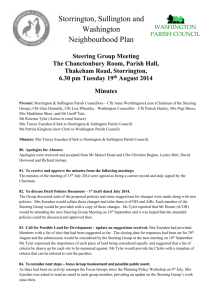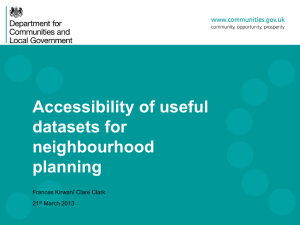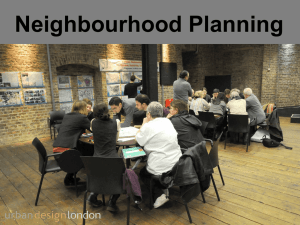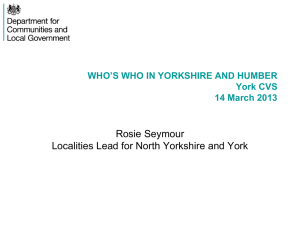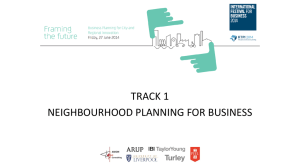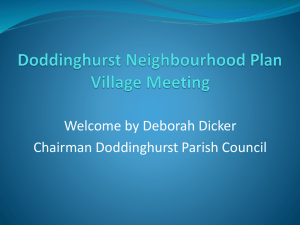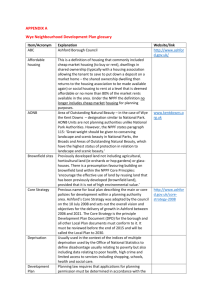Chapel Vision- Neighbourhood plan
advertisement
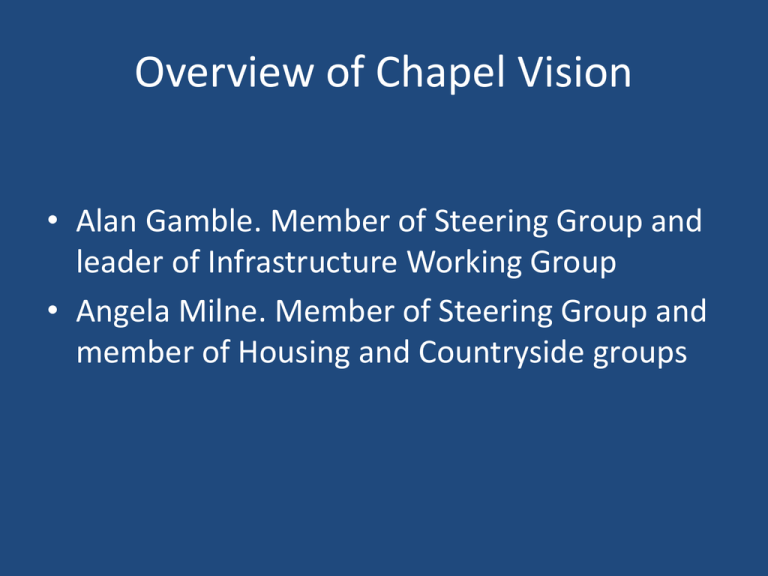
Overview of Chapel Vision • Alan Gamble. Member of Steering Group and leader of Infrastructure Working Group • Angela Milne. Member of Steering Group and member of Housing and Countryside groups What is Chapel vision • Group of resident who want to involve as many of the local residents as possible to plan and develop improvements for our area • Supported by High Peak Borough Council (HPBC) and Chapel-en-le-frith Parish Council but independent from it • Investigate & identify support for community led plan • Identify ways of involving the whole community & gather views from local groups /organisations • Identify priorities and timescales for local action in the action plan and potential sources of funding Formation of Chapel Vision • Formed following 5 community events in Chapel Parish with facilitator from Rural Action Derbyshire • Volunteers for steering group and working groups requested at meeting • Exercises captured key community concerns • No formal record of output - would have been nice • E-mail addresses of attendees needed to be put on formal database Current status • Formal structure with memorandum of understanding with HPBC • Steering group • Working groups include housing, countryside, infrastructure and transport • Website available for information & communication • Budget of £20,000 (£8000 for referendum) • Questionnaire distributed to all residents with prepaid reply envelope • Transcription of the 900+ questionnaire responses in progress • Some WGs have begun to draft the test for their section of the Neighbourhood Plan 3 Way working CV /PC/HPBC • HPBC provided officers support to provide advice e.g. sustainability report requirements, housing needs, identified brown field sites. • HPBC requirements for a robust neighbourhood plan defined • PC has provided support via town clerk and council members • Channels of communications agreed avoid bureaucracy but maintain efficiency Things that worked well • Regular meetings of the Steering Committee, and good communication between meetings • Use of local experts (e.g. lawyer) • Involving local expert organisations (e.g. DWT, DCC, etc) • Obtaining relevant documented examples: PC, HPBC &DCC • Splitting work into subgroups • Surveying local opinion through a questionnaire • Obtaining list of interested residents with their interest area • The involvement of PCs on each subgroup Challenges & how we overcame them Challenge Solution Getting to as many residents as possible Multi-location events Trying to ensure that all communities felt part of CV Try to use examples from each area. Try to involve volunteers from each area Processing the huge number of returned survey sheets Paid data input person Spread sheet pre-programmed Ensuring all working groups are mutually inclusive Regular SG meetings; monthly reports from WG’s, group leader dialogue Challenges & how we overcame them (continued) Challenge Solution Understanding what is a neighbourhood plan Use parish plans, village design statements, concept statements, community lead planning toolkit, neighbourhood planning guidance Understanding the legal framework requirements Memorandum of understanding Declaration of members interests Understanding where your community fits Draft core strategy & timescales into the new planning process Local development framework Ensuring the views of the community are represented Easy to represent the views of subgroup Questionnaire returns & evidence of response Things we could have done better • Involve local council (HPBC) earlier • Get a robust questionnaire- everything covered • Be less influenced buy unreal timescales that continually shifted • Set realistic and clear targets for subgroups • Start early to think of key issues in the community • Get sub- group leaders to meet and go over key issues per group Next steps • • • • • Analysis of all the survey data Merging the outputs of the different groups Documenting the neighbourhood plan The referendum Using the Neighbourhood Plan to generate / support projects and initiatives in our parish


